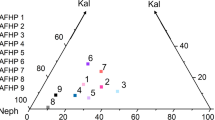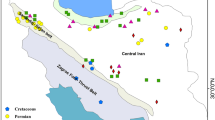Abstract
A microbeam (electron microprobe, X-ray diffraction and Raman) study of pseudomorphs after magmatic perovskite from kimberlite (Iron Hill, Wyoming, USA) and carbonatite (Prairie Lake, Ontario, Canada) showed that the early product of perovskite replacement in these samples is kassite, a monoclinic (space group P21/a) polymorph of CaTi2O4(OH)2. This mineral can be readily distinguished from its dimorph cafetite (space group P21/n) based on the presence of strong signals at ~120, 300, 330, 450, 470 and 690 cm−1, and the absence or very low intensity of signals at ~250, 420, 600, 800 and 825 cm−1 in its Raman spectrum. The strongest X-ray diffraction lines, measured for the Prairie Lake material, are [d obs in Å (I) hkl]: ~3.29 (100) 022; 112, \( {\mathrm{11}}{\overline 2} \); 1.764 (61) \( {\mathrm{13}}{\overline 4} \); 2.284 (45) 132; 2.601 (24) 130; 2.050 (17) 222; 4.81 (16) 002; 2.034 (15) 042; 2.308 (14) 202; 1.778 (14) \( {\mathrm{20}}{\overline 4} \). Diffraction lines at 3.60, 2.99, 2.79, 2.57, 2.56 and 1.91 Å, characteristic of cafetite, are not observed. The electron-microprobe analyses of kassite give formulae close to the stoichiometric composition. Progressive Ca leaching leads to replacement of kassite by anatase + calcite, which are also commonly observed as direct products of perovskite alteration in silica-undersaturated igneous rocks. Raman spectroscopy is the fastest and most reliable technique to identify submicroscopic anatase–calcite intergrowths that can be easily mistaken for kassite (cafetite) based on electron-microprobe data. Thermodynamic calculations indicate that conversion of perovskite into kassite and, subsequently, anatase requires initially high levels of f(H2O) in the system, followed by an increase in f(CO2) at either decreasing or constant T and f(H2O). The implications of perovskite–kassite–anatase phase relations for deciphering the late-stage evolution of kimberlites and carbonatites are discussed.





Similar content being viewed by others
References
Authier-Martin M, Forté G, Ostap S, See J (2001) The mineralogy of bauxite for producing smelter grade alumina. J Mineral Met Mater Soc 53(12):36–40
Banfield J, Veblen DR (1992) Conversion of perovskite to anatase and TiO2 (B): a TEM study and the use of fundamental building blocks for understanding relationships among the TiO2 minerals. Am Mineral 77:545–557
Bulakh AG, Krivovichev VG, Zolotarev AG (1995) Mineral formulae. Thermodynamic analysis in mineralogy and geochemistry. St. Petersburg University Press, Russia (in Russian)
Chakhmouradian AR (2004) Crystal chemistry and paragenesis of compositionally unique (Al-, Fe-, Nb- and Zr-rich) titanite from Afrikanda, Russia. Am Mineral 89:1752–1762
Chakhmouradian AR, Mitchell RH (2000) Occurrence, compositional variation and alteration of perovskite in kimberlites. Can Mineral 38:975–994
Chakhmouradian AR, Zaitsev AN (2002) Calcite–amphibole–clinopyroxene rock from the Afrikanda complex, Kola Peninsula, Russia: mineralogy and a possible link to carbonatites. III. Silicate minerals. Can Mineral 40:1347–1374
Chakhmouradian AR, Reguir EP, Kamenetsky VS, Sharygin VV, Golovin AV (2013) Trace-element partitioning in perovskite: implications for the geochemistry of kimberlites and other mantle-derived undersaturated rocks. Chem Geol 353:112–131
Chermak JA, Rimstidt JD (1990) Estimating the free energy of formation of silicate minerals at high temperatures from the sum of polyhedral contributions. Am Mineral 75:1376–1380
Dong W, Song B, Zhao G, Han G (2013) Synthesis and characterization of CaTi2O4(OH)2 nanosheets for lithium-ion battery. Int J Electrochem 8:4551–4559
Evans HT, Dwornik EJ, Milton C (1986) Kassite from the Diamond Jo quarry, Magnet Cove, Hot Spring County, Arkansas: the problem of cafetite and kassite. Am Mineral 71:1045–1048
Grey IE, Mumme WG, Perov IV, Pushcharovsky DYu (2003) The crystal structure of chromian kassite from the Saranovskoye deposit, Northern Urals, Russia. Am Mineral 88:1331–1335
Holland TJB, Redfern SAT (1997) UNITCELL—a nonlinear least-squares program for cell parameter refinement implementing regression and deletion diagnostics. J Appl Crystallogr 30:84
Huang YJ, Tsai MC, Chiu HT, Sheu HS, Lee CY (2010) Artificial synthesis of platelet-like kassite and its transformation to CaTiO3. Cryst Growth Design 10:1221–1225
Krivovichev SV, Yakovenchuk VN, Burns PC, Pakhomovsky YA, Menshikov YP (2003) Cafetite, Ca[Ti2O5](H2O): crystal structure and revision of chemical formula. Am Mineral 88:424–429
Kukharenko AA, Kondrat’yeva VV, Kovyazina VM (1959) Cafetite—a new hydrous titanate of calcium and iron. Zap Vses Mineral Obshch 88(4):444–453 (in Russian)
Kukharenko AA, Orlova MP, Bulakh AG, Bagdasarov EA, Rimskaya-Korsakova OM, Nefedov EI, ll’inskiy GA, Sergeev AS, Abakumova NB (1965) The Caledonian complex of ultrabasic alkalic rocks and carbonatites of the Kola Peninsula and northern Karelia. Nedra, Moscow, pp 368–375 (in Russian)
Miao L, Tanemura S, Toh S, Kaneko K, Tanemura M (2004) Fabrication, characterization and Raman study of anatase-TiO2 nanorods by a heating-sol-gel template process. J Cryst Growth 264:246–252
Mitchell RH, Chakhmouradian AR (1998) Instability of perovskite in a CO2-rich environment: examples from carbonatite and kimberlite. Can Mineral 36:939–952
Moiseev MM, Chukanov NV (2006) Mineralogy of alkaline pegmatites and hydrothermalites of the Kovdor phlogopite deposit. Novye Dannye Mineral 41:56–70 (in Russian)
Moreira ML, Paris EC, do Nascimento GS, Longo VM, Sambrano JR, Mastelaro VR, Bernardi MIB, Andrés J, Varela JA, Longo E (2009) Structural and optical properties of CaTiO3 perovskite-based materials obtained by microwave-assisted hydrothermal synthesis: an experimental and theoretical insight. Acta Mater 57:5174–5185
Nesbitt HW, Bancroft GM, Fyfe WS, Karkhanis SN, Nishijima A, Shin S (1981) Thermodynamic stability and kinetics of perovskite dissolution. Nature 289:358–362
Pekov IV, Schneider J, Pushcharovsky DYu (2004) On the X-ray powder diffractogram of kassite and its relationship with cafetite. Zap Vseross Mineral Obshch 133(3):51–54 (in Russian)
Pereira VP, Conceição RV, Formoso MLL, Pires AC (2005) Alteration of perovskite to anatase in silica-undersatured rocks of the Catalão-I carbonatite complex, Brazil: a Raman study. Rev Brasil Geociên 35:239–244
Pouchou JL, Pichoir F (1985) “PAP” (φ-ρ-Z) correction procedure for improved quantitative microanalysis. In: Armstrong JT (ed) Microbeam analysis. San Francisco Press, San Francisco, pp 104–106
Ringwood AE, Kesson SE, Ware NG, Hibberson W, Major A (1979a) The SYNROC process: a geochemical approach to nuclear waste immobilization. Geochem J 13:141–165
Ringwood AE, Kesson SE, Ware NG, Hibberson W, Major A (1979b) Immobilisation of high level nuclear reactor wastes in SYNROC. Nature 278:219–223
Robertson DW (1936) Lead titanate. Indust Eng Chem 28:216–218
Rudashevsky LS, Firfarova IB, Tsekhovol’skaya DI (1977) Synthetic analogue and refinement of the properties of kassite and hydrokassite. Zap Vses Mineral Obshch 106(1):114–120
Schuiling RD, Vink BW (1967) Stability relations of some titanium-minerals (sphene, perovskite, rutile, anatase). Geochim Cosmochim Acta 31:2399–2411
Self PG, Buseck PR (1991) Structure model for kassite, CaTiO2O4(OH)2. Am Mineral 76:283–287
Yakovenchuk VN, Ivanyuk GY, Pakhomovsky YA, Men’shikov YP (2005) Khibiny. Laplandia Minerals, Apatity
Yu S, Li S, Liu K, Zhuang L, Li Z (1982) A preliminary study on the mineralogy of the Zhaoanzhuang-type iron ore deposit Wuyang, Henan Province, China. Zhong Dizhi Kex Yichan Dizhi Kuang Yanj Sokan 5:1–22 (in Chin)
Zajzon N, Váczi T, Fehér B, Takács Á, Szakáll S, Weiszburg TG (2013) Pyrophanite pseudomorphs after perovskite in Perkupa serpentinites (Hungary): a microtextural study and geological implications. Phys Chem Miner 40:611–623
Zheng H, Csete de Györgyfalva GDC, Quimby R, Bagshaw H, Ubic R, Reaney IM, Yarwood J (2003) Raman spectroscopy of B-site order–disorder in CaTiO3-based microwave ceramics. J Eur Ceram Soc 23:2653–2659
Acknowledgments
The present work was supported by the Fundação para a Ciência e Tecnologia, Portugal (TM), Natural Sciences and Engineering Research Council of Canada (ARC) and the National Research Council of Italy (LM). The Raman equipment used in this work was acquired with funds provided by the Canada Foundation for Innovation. We are grateful to Viktor N. Yakovenchuk, Anatoly N. Zaitsev and R. Garth Platt for providing us with the samples of Khibiny cafetite, Kerimasi nephelinite and Prairie Lake carbonatite, respectively, and to Ravinder Sidhu for her help with the electron-microprobe analyses. We also acknowledge Evgeny Galuskin and an anonymous reviewer for their constructive comments on the earlier version of this paper and Patrick M. Woodward for editorial handling.
Author information
Authors and Affiliations
Corresponding author
Electronic supplementary material
Below is the link to the electronic supplementary material.
Rights and permissions
About this article
Cite this article
Martins, T., Chakhmouradian, A.R. & Medici, L. Perovskite alteration in kimberlites and carbonatites: the role of kassite, CaTi2O4(OH)2 . Phys Chem Minerals 41, 473–484 (2014). https://doi.org/10.1007/s00269-014-0667-z
Received:
Accepted:
Published:
Issue Date:
DOI: https://doi.org/10.1007/s00269-014-0667-z




